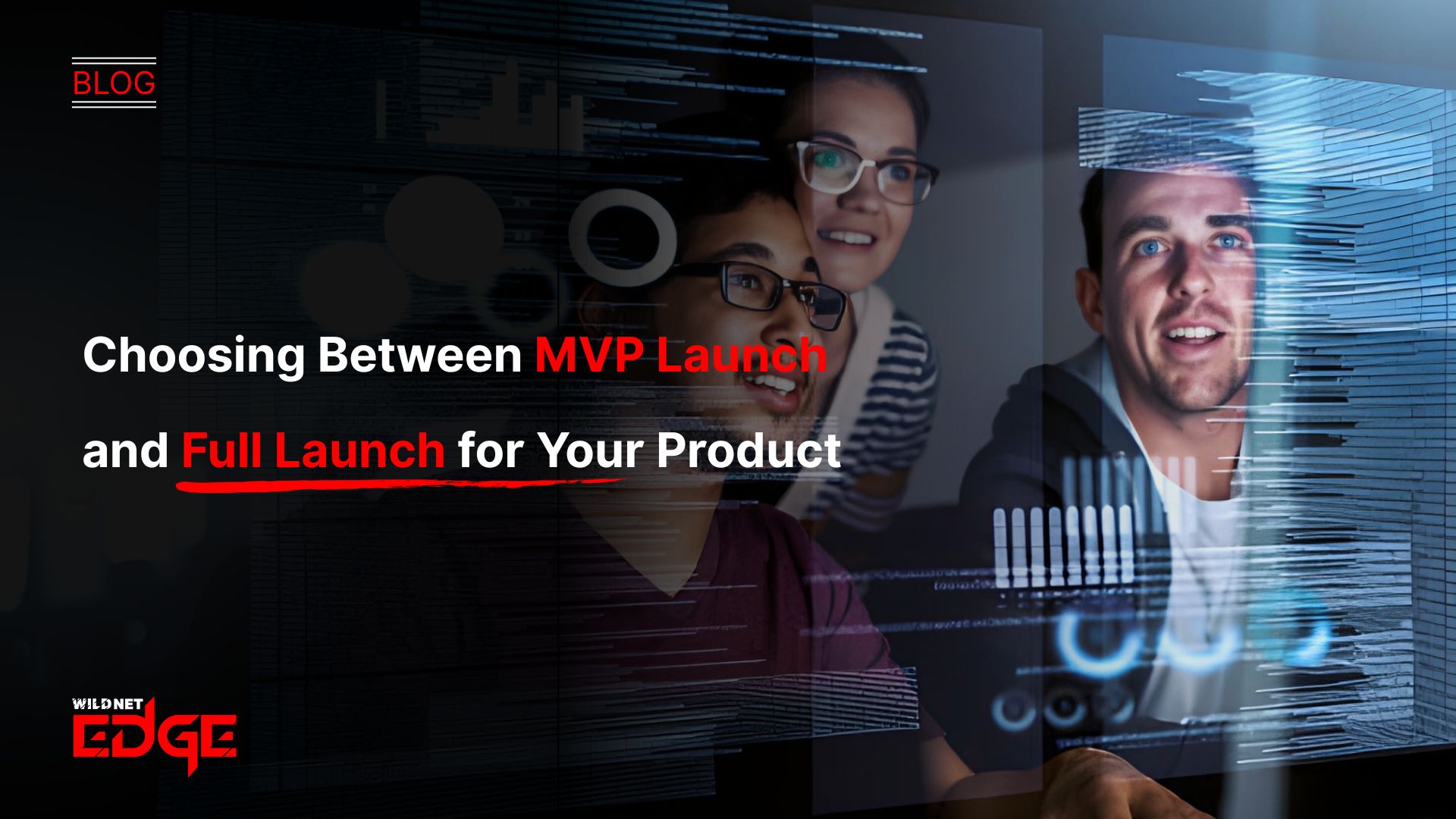TL;DR
This article explores the critical decision between an MVP vs full launch. It defines an MVP as a lean, focused release aimed at rapid product validation and early market testing, which minimizes risk and cost. In contrast, a full launch is a high-cost, high-impact release of a feature-complete product. The guide details the pros and cons of each app release plan, emphasizing that the MVP vs full launch choice depends on a startup’s funding, risk tolerance, and market certainty. For most startups, an MVP is presented as the strategically smarter path to test assumptions before committing to a full-scale build.
You’ve got a brilliant idea that keeps you up at night because you know it could make an impact. But before you dive in, there’s one big question: Should you go for a full product launch, or start small with a Minimum Viable Product (MVP)?
This decision MVP vs full launch, can define your startup’s entire journey: your budget, timeline, risk level, and ultimately, your success. Let’s break it down and help you make the right call.
What is an MVP Launch?
An MVP launch is a strategic, lean approach. It is not a cheap or incomplete version of your product; it’s a focused version. The core purpose of an MVP is product validation. It is designed to answer your riskiest assumptions with the least amount of effort and capital.
An MVP launch targets a small, specific group of early adopters. The goal is not to capture the entire market, but to start the “Build-Measure-Learn” feedback loop as quickly as possible. This approach of early market testing is central to most modern startup app launch strategies, allowing you to iterate based on real user data, not just internal hypotheses.
What is a Full Product Launch?
A full product launch, also known as a “big bang” release, is the traditional approach to introducing a new product. It involves developing a feature-complete, highly polished, and market-ready application before releasing it to the entire target audience at once.
A significant, coordinated marketing and public relations campaign typically accompanies this launch. It assumes that the product’s value proposition is strong and that product validation has either been established or is guaranteed by the brand’s existing reputation. A full product launch aims for immediate market impact and revenue, a sharp contrast to the learning-focused MVP launch.
The Core Tradeoffs: MVP vs Full Launch
The strategic decision in the MVP vs full launch debate comes down to a series of critical tradeoffs between risk, speed, cost, and learning.
| Factor | MVP Launch | Full Product Launch |
| Primary Goal | Learning & Validation | Market Capture & Revenue |
| Risk | Low financial risk; risk of being too minimal | High financial risk; risk of building the wrong product |
| Speed (Time-to-Market) | Very Fast (e.g., 3-5 months) | Very Slow (e.g., 9-18+ months) |
| Initial Cost | Low | Very High |
| Feedback Loop | Gathers real-world feedback to guide iteration | Feedback comes after launch, making changes difficult |
| Market Strategy | Validates a market | Assumes a market exists |
Why Most Startups Should Choose an MVP Launch
For most new founders, an MVP launch is the best route. The biggest reason startups fail is simple: no market need.
An MVP helps you test that before you spend a fortune. Through product validation and early market testing, you can confirm whether people actually want what you’re building and whether they’ll pay for it.
This lean approach protects your resources and gives you proof of concept. Even better, an MVP with solid traction is a powerful story for investors. It’s real evidence that your idea works not just a pitch deck. In the MVP vs full launch debate, think of it this way: the MVP path helps you learn fast, fail cheap, and build smarter.
Engaging a partner for MVP development services is often the most efficient way to get this lean, focused product built and launched quickly.
When Does a Full Launch Make Sense?
While an MVP is the default for most, a full product launch is a valid app release plan in specific contexts:
- Established Companies: An established brand like Apple or Microsoft launching a new, adjacent product has a built-in audience, massive marketing budget, and high brand trust, justifying a full product launch.
- Proven Sequels: If you are launching Version 2.0 of an already-successful product, the market is validated, and users expect a feature-rich update.
- High-Funded, “Winner-Take-All” Markets: In rare cases, a startup may raise a massive seed or Series A round to attempt an immediate full product launch and capture an entire new market at once. This is an extremely high-risk strategy.
- Hardware-Dependent Products: It is much harder to iterate on physical hardware. These products often require a full product launch because the “minimum viable” standard is much higher.
This clear strategic difference is at the heart of the MVP vs full launch decision.
Case Studies in Launch Strategy
Examining real-world examples helps illustrate the MVP vs full launch tradeoff.
Case Study 1: The MVP Success (Dropbox)
- The Challenge: Drew Houston had a complex idea for cloud file-syncing. Building the full, robust infrastructure for a full product launch would have taken years and millions.
- The Strategy: He chose an MVP. But his MVP wasn’t even a full application—it was a simple video demonstrating the intended functionality. This was the leanest possible way to test his core assumption.
- The Result: The video drove hundreds of thousands of sign-ups to the waitlist overnight. This extreme product validation proved the market need before the complex product was built, securing the funding to build it right.
Case Study 2: The Full Launch Risk (Quibi)
- The Challenge: A heavily funded media company wanted to launch a new, premium short-form video platform for mobile.
- The Strategy: They raised nearly $2 billion and chose a full product launch. They spent lavishly on star-studded content and a massive marketing “big bang” launch.
- The Result: The launch was a notorious failure. They built a feature-complete product without validating their core assumptions (e.g., “Do people want high-production, short-form content only on mobile?”). They skipped the early market testing phase and built a product the market didn’t want. This is the ultimate cautionary tale in the MVP vs full launch debate.
Our Technology Stack for Launch Readiness
A successful launch, whether an MVP or a full product launch, requires a modern, scalable technology stack.
- Frontend: React, Angular, Vue.js (for web); Flutter, React Native (for mobile MVPs)
- Backend: Node.js, Python, Go (for scalable, modern backends)
- Cloud: AWS, Azure, GCP (for scalable infrastructure)
- DevOps: Docker, Kubernetes, Terraform (to automate and manage scaling)
This stack supports the full app development process from a simple MVP to a globally scaled application.
Conclusion
The MVP vs full launch decision is one of the most critical strategic choices a founder will make. While a full product launch offers a powerful “big bang” moment, it carries immense financial and market risk. For the vast majority of startups, the MVP approach focused on early market testing and product validation is the proven, intelligent, and capital-efficient path to building a sustainable business. It’s not about launching a small product; it’s about launching in a smart way.
Ready to build a product that your market actually wants? At Wildnet Edge, our AI-first approach enhances our development process. We are your expert partner in navigating the MVP vs full launch dilemma, building lean, high-value products that find product-market fit faster.
FAQs
The biggest risk is building something nobody wants. You can spend millions of dollars and years of development on a polished product, only to launch it and find that your core assumptions about the market need were wrong.
You must be ruthless in your prioritization. An MVP should include only the essential features that solve the single most important problem for your single most important user. Ask yourself: “Can we validate our core hypothesis without this feature?” If the answer is yes, cut it.
Large enterprises use the MVP approach all the time. It’s a key strategy for mitigating risk when entering a new market or launching a new, unproven product line. It allows them to test an idea without risking their core brand’s reputation on a full, unvalidated launch.
Yes. A soft launch is often the method used to release an MVP. It’s a limited release to a small geographic area or a specific group of users. This is a key technique for early market testing the MVP with real users in a controlled environment before a full marketing push.
An MVP is highly successful at attracting investors. A validated MVP with real user data is infinitely more fundable than a simple idea on a slide deck. It proves you can execute and that your market exists.
MVP marketing is highly targeted, and focused on learning. The goal is to find a small group of early adopters at a low cost. A full product launch involves a massive, expensive, “big bang” marketing campaign designed to reach the entire market at once.
That’s a good thing! The MVP has successfully done its job: it has saved you millions of dollars and years of time. A “failed” startup app launch provides invaluable data. You can now analyze why it failed (Was the problem not real? Was the solution bad?) and decide to pivot your product or stop the project.

Nitin Agarwal is a veteran in custom software development. He is fascinated by how software can turn ideas into real-world solutions. With extensive experience designing scalable and efficient systems, he focuses on creating software that delivers tangible results. Nitin enjoys exploring emerging technologies, taking on challenging projects, and mentoring teams to bring ideas to life. He believes that good software is not just about code; it’s about understanding problems and creating value for users. For him, great software combines thoughtful design, clever engineering, and a clear understanding of the problems it’s meant to solve.
 sales@wildnetedge.com
sales@wildnetedge.com +1 (212) 901 8616
+1 (212) 901 8616 +1 (437) 225-7733
+1 (437) 225-7733































